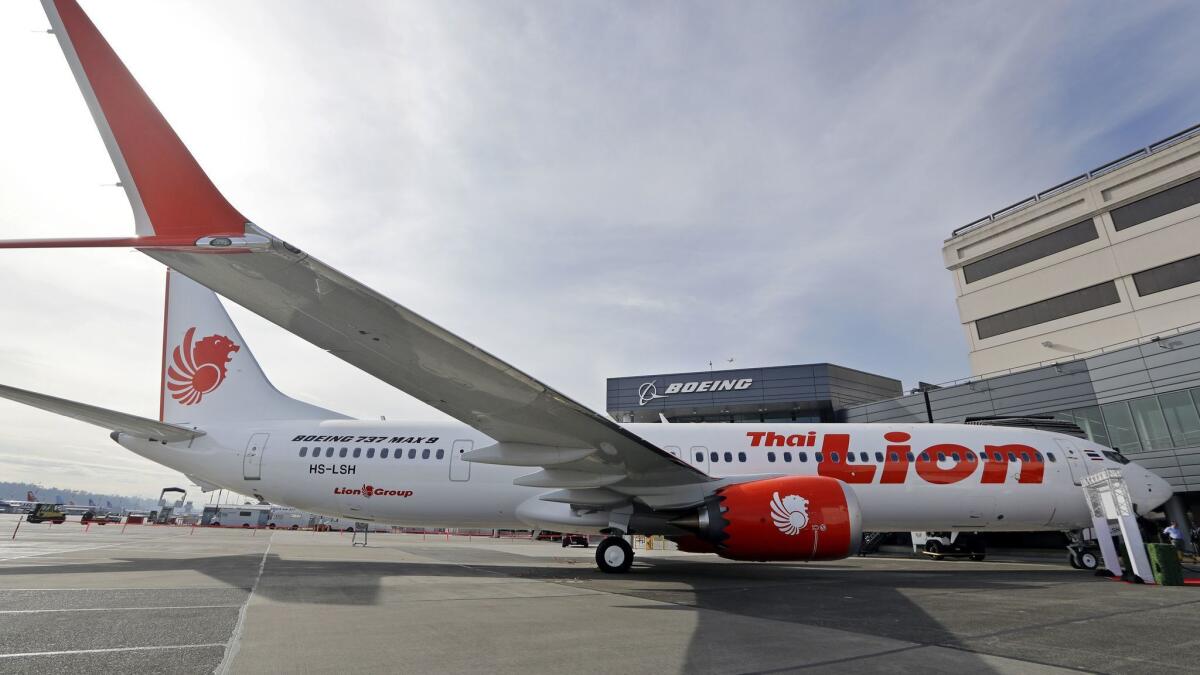Federal regulators eye software fix for new version of Boeing 737 that crashed off Indonesia

- Share via
Boeing Co. and U.S. aviation regulators are weighing whether to issue a software fix for the 737 Max, the aircraft type involved in a deadly crash in Indonesia last month, to ensure that the plane won’t dive aggressively without pilot commands.
The manufacturer and the Federal Aviation Administration “continue to evaluate the need for software and or other design changes to the aircraft,” the agency said in a statement Tuesday.
A safety feature added to the updated 737 Max, which was designed to prevent pilots from losing control, has been implicated by Indonesian investigators in a Lion Air jet’s sudden dive into the Java Sea after taking off from Jakarta on Oct. 29. The pilots were attempting to deal with several malfunctions when the crash occurred, the investigators said.
All 189 people aboard died in the high-velocity impact.
The FAA and Boeing are also evaluating the need for other upgrades, “including operating procedures and training,” the regulator said in the statement. The FAA on Nov. 7 issued an emergency airworthiness directive ordering U.S. airlines to incorporate information about the feature in their pilot manuals.
Two U.S. pilot unions at carriers flying the Max said Monday that Boeing didn’t adequately spell out how the new system worked in training and manuals.
The Chicago-based aerospace giant didn’t immediately respond to a request for comment on the FAA statement. The company said Monday it is confident in the safety of the 737 Max family of jets, a message echoed Tuesday by Chief Executive Officer Dennis Muilenburg.
“The bottom line here is the 737 Max is safe,” Muilenburg said on Fox Business Network. “This airplane went through thousands of hours of tests and evaluations, certification, working with the pilots, and we’ve been very transparent on providing information and being fully cooperative on the investigative activity.”
While the investigation into the Lion Air crash is far from complete, investigators believe that an erroneous sensor prompted a computerized safety system to aggressively push the jet into a dive, according to Indonesia’s National Transportation Safety Committee. Other factors, such as maintenance on the plane and the pilots’ performance, may also become factors in the accident.
Boeing and the FAA last week issued directives to airlines to alert their pilots that they can resolve such a problem using an existing emergency procedure.
The Maneuvering Characteristics Augmentation System, which was added to the Max to make it less likely that pilots point the plane’s nose so high that the wings lose lift, takes data from sensors and in limited circumstances commands a dive. The software in the computer system that drives the MCAS can be altered without having to redesign components on the plane.
Shares of Boeing were down $1.02, or a fraction of a percent, to $348.75 in morning trading Wednesday.
More to Read
Inside the business of entertainment
The Wide Shot brings you news, analysis and insights on everything from streaming wars to production — and what it all means for the future.
You may occasionally receive promotional content from the Los Angeles Times.










